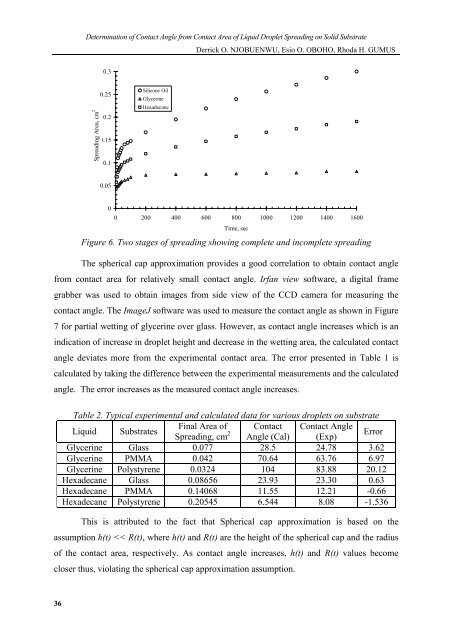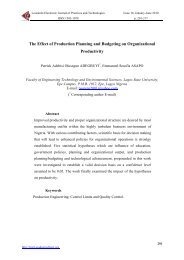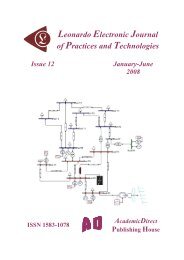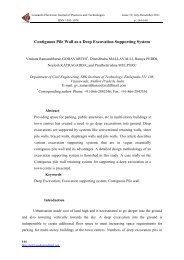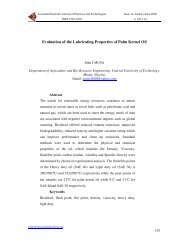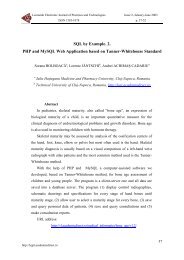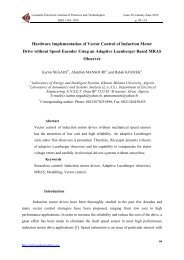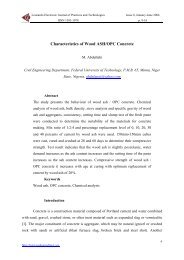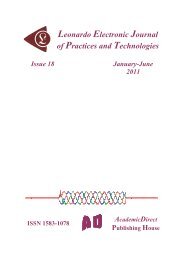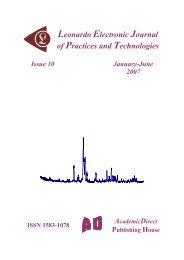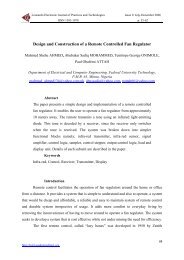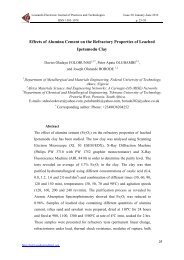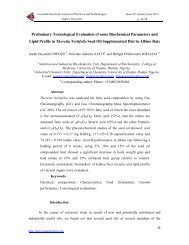Determination of Contact Angle from Contact Area of Liquid Droplet ...
Determination of Contact Angle from Contact Area of Liquid Droplet ...
Determination of Contact Angle from Contact Area of Liquid Droplet ...
You also want an ePaper? Increase the reach of your titles
YUMPU automatically turns print PDFs into web optimized ePapers that Google loves.
36<br />
<strong>Determination</strong> <strong>of</strong> <strong>Contact</strong> <strong>Angle</strong> <strong>from</strong> <strong>Contact</strong> <strong>Area</strong> <strong>of</strong> <strong>Liquid</strong> <strong>Droplet</strong> Spreading on Solid Substrate<br />
Derrick O. NJOBUENWU, Esio O. OBOHO, Rhoda H. GUMUS<br />
Spreading <strong>Area</strong>, cm 2<br />
0.3<br />
0.25<br />
0.2<br />
0.15<br />
0.1<br />
0.05<br />
0<br />
Silicone Oil<br />
Glycerine<br />
Hexadecane<br />
0 200 400 600 800<br />
Time, sec<br />
1000 1200 1400 1600<br />
Figure 6. Two stages <strong>of</strong> spreading showing complete and incomplete spreading<br />
The spherical cap approximation provides a good correlation to obtain contact angle<br />
<strong>from</strong> contact area for relatively small contact angle. Irfan view s<strong>of</strong>tware, a digital frame<br />
grabber was used to obtain images <strong>from</strong> side view <strong>of</strong> the CCD camera for measuring the<br />
contact angle. The ImageJ s<strong>of</strong>tware was used to measure the contact angle as shown in Figure<br />
7 for partial wetting <strong>of</strong> glycerine over glass. However, as contact angle increases which is an<br />
indication <strong>of</strong> increase in droplet height and decrease in the wetting area, the calculated contact<br />
angle deviates more <strong>from</strong> the experimental contact area. The error presented in Table 1 is<br />
calculated by taking the difference between the experimental measurements and the calculated<br />
angle. The error increases as the measured contact angle increases.<br />
Table 2. Typical experimental and calculated data for various droplets on substrate<br />
<strong>Liquid</strong> Substrates<br />
Final <strong>Area</strong> <strong>of</strong><br />
Spreading, cm 2<br />
<strong>Contact</strong><br />
<strong>Angle</strong> (Cal)<br />
<strong>Contact</strong> <strong>Angle</strong><br />
(Exp)<br />
Error<br />
Glycerine Glass 0.077 28.5 24.78 3.62<br />
Glycerine PMMA 0.042 70.64 63.76 6.97<br />
Glycerine Polystyrene 0.0324 104 83.88 20.12<br />
Hexadecane Glass 0.08656 23.93 23.30 0.63<br />
Hexadecane PMMA 0.14068 11.55 12.21 -0.66<br />
Hexadecane Polystyrene 0.20545 6.544 8.08 -1.536<br />
This is attributed to the fact that Spherical cap approximation is based on the<br />
assumption h(t)


